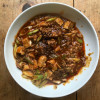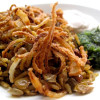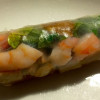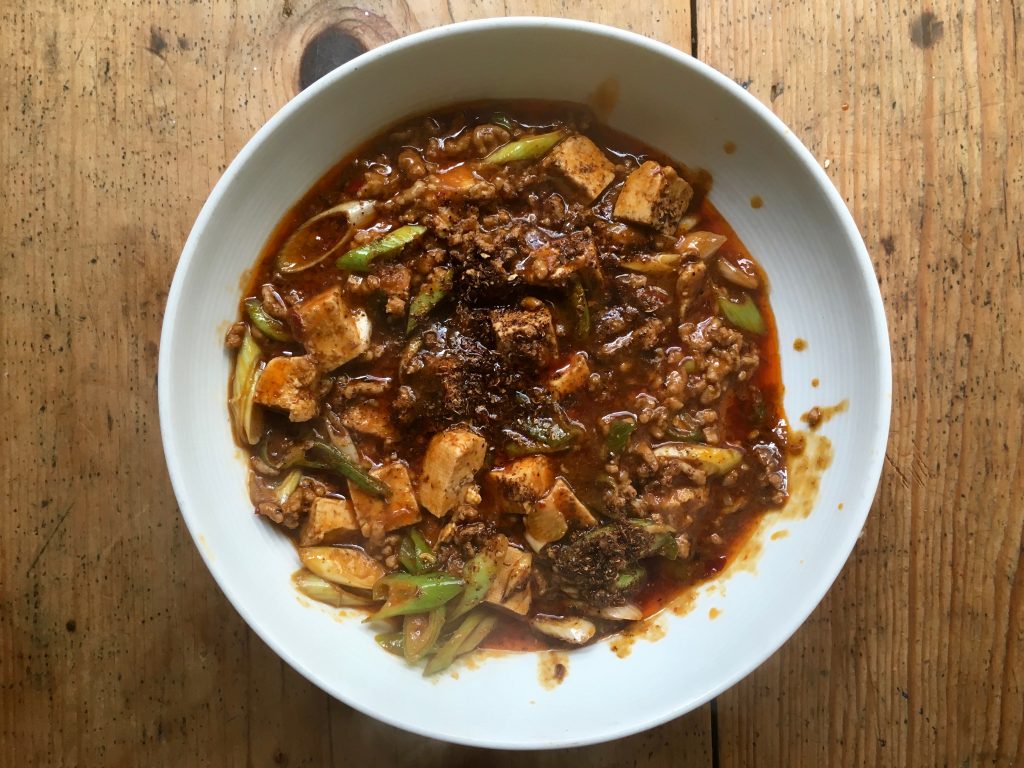 Probably one of the most famous Chinese tofu dishes, Mapo Tofu translates roughly as “pockmarked old woman’s bean curd”. It’s a Sichuan staple, and my version is inspired by lunch recently at Barshu in Soho.
Probably one of the most famous Chinese tofu dishes, Mapo Tofu translates roughly as “pockmarked old woman’s bean curd”. It’s a Sichuan staple, and my version is inspired by lunch recently at Barshu in Soho.
According to your source, it’s either just something served by the smallpox marked wife of a Chengdu restaurateur, renowned for helping tired, hungry labourers in need of a spicy pick-me-up. Or it was inspired by a customer who left behind a bag of beef mince in the restaurant; shortly after a table of customers arrives all demanding a tofu dish with beef so the parsimonious pock-marked proprietor uses the misplaced beef mince with the tofu to the apparent delight of her clientele.
Whatever your backstory preference it’s a spicy, oily mess of loveliness with an appealing balance of textures and flavours – very warming on a cold winter’s day. It’s also a good way of experiencing the “ma-la” (Ma = “numbing”, La = “hot”) flavour that characterises many Sichuan dishes, a combination of chillies and Sichuan peppers.
Sichuan peppers
No relation of black pepper at all, these pokey little seeds are actually part of the citrus family. They have a tangy flavour – not hot or even peppery – but it’s the incredible tingling, numbing effect they create on your lips and tongue that makes them so interesting. This effect – known as paresthesia – is apparently caused by a molecule that makes your cells’ touch receptors feel like they’ve been vibrated quickly.
In Mapo Tofu, the peppers are roasted slightly then ground so along with the lemony, tingling sensation there’s that delicious toasted flavour. This powder is sprinkled on top of the finished dish to give it a unique flavour.
Douban Jiang
At the heart of Mapo Tofu is the chilli bean sauce known as Douban Jiang – it’s a hot, thick sauce with a deep, savoury flavour made from dried broad beans with fresh red chillis, salt and wheat flour. It’s fermented for between one and eight years – the older it is, the more intense the flavour – and the best kind comes from Pixian county and uses the region’s “facing heaven chilli”, so called because it points upwards at it grows.
Read more about it and other great Sichuan ingredients and dishes here:
http://themalaproject.com/pixian-chili-bean-paste-douban-jiang/
The version I’ve made here uses a new Lee Kum Kee sauce called Sichuan Toban Chilli Sauce. It’s not 100% Douban Jiang, but it does the job perfectly and uses authentic Pixian Douban Jiang as the core ingredient.
Fermented Black Beans
More richness and depth comes from the use of fermented black beans (douchi) – a preserved soybean with a salty, complex flavour. The process of preserving soy beans in large, covered earthenware pots dates back over 2000 years.
What Is Tofu?
Just in case you’ve never asked the question before – what exactly is tofu? It’s made in a similar way to cheese. Firstly you need soy milk. You get that by soaking soy beans then grinding them up in water. You then boil then resulting emulsion which improves the flavour then filter off any unwanted bits and bobs.
Once you have the soy milk you add a coagulant (a salt or an acid) – traditionally in China, they use gypsum or Nigari salts – to separate out the curd from the whey. The resulting curds are then pressed to create the solid edible mass beloved of vegetarians everywhere.
There are three main types: silken tofu, firm tofu or dry tofu depending on how much liquid has been pressed out. Here I’m using Dragonfly Organic Tofu, because they’re based in Buckfastleigh, just round the corner from my hometown.
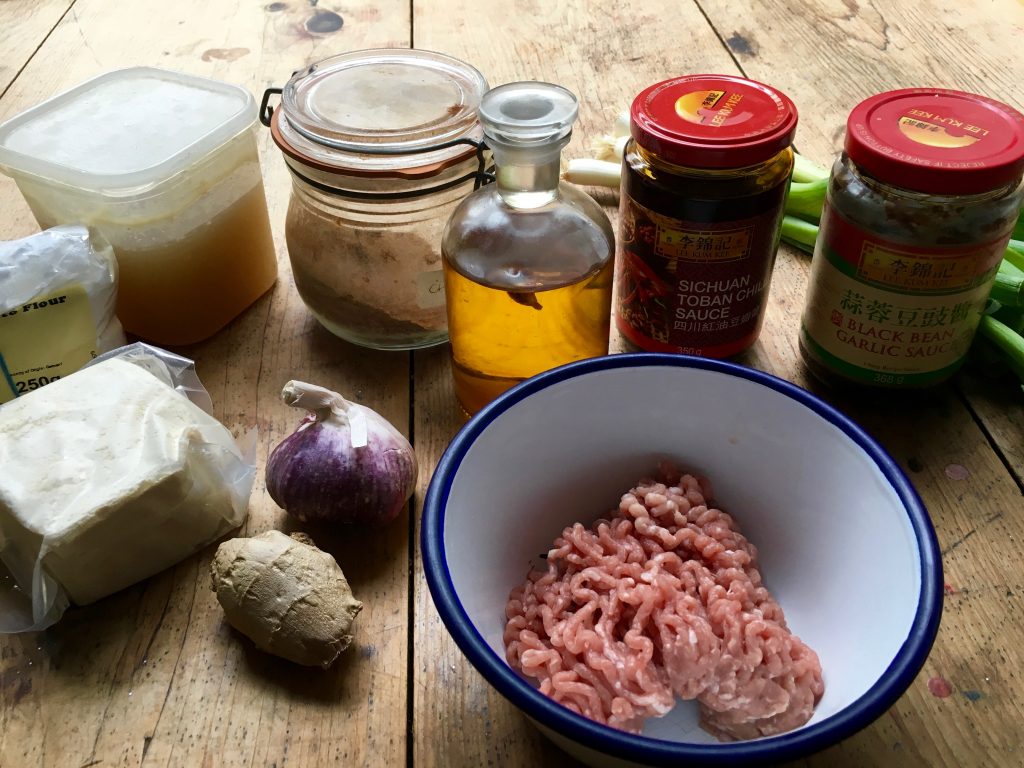 How to make Mapo Tofu
How to make Mapo Tofu
There are several versions of Mapo Tofu, but there are some essentials you can’t do without. Firstly there’s the tofu itself and the mince – beef or pork. You can vary the amounts of each according to taste; generally much more tofu than meat, or omit the meat altogether for a veggie version.
Then you absolutely need the chilli bean paste, the Sichuan pepper and chilli oil to achieve the desired effect. Variations I’ve seen include using leeks instead of spring onions, hoi sin sauce, gochugaru (Korean chilli powder), and soy sauce. I’d say that none of these is entirely necessary.
Get all your ingredients prepared and handy as it takes only a few minutes to cook.
Ingredients for Mapo Tofu
(My photos show the ingredients I used for one person. Although I was hungry and I do like a big portion of this stuff so you might get away with these for two. Below are the quantities for four people)
- 2 tbs potato flour
- 500ml chicken stock
- 500g soft tofu cut into 2cm cubes
- 250g minced pork or beef
- 3 tbs finely chopped garlic
- 3 tbs grated ginger
- 5 tbs douban jiang
- 4 large spring onions, trimmed and sliced diagonally into thin “ears”
- 1 tbs fermented black bean paste
- 4 tbs chilli oil
- 1 tbs Sichuan pepper
- Rice to serve
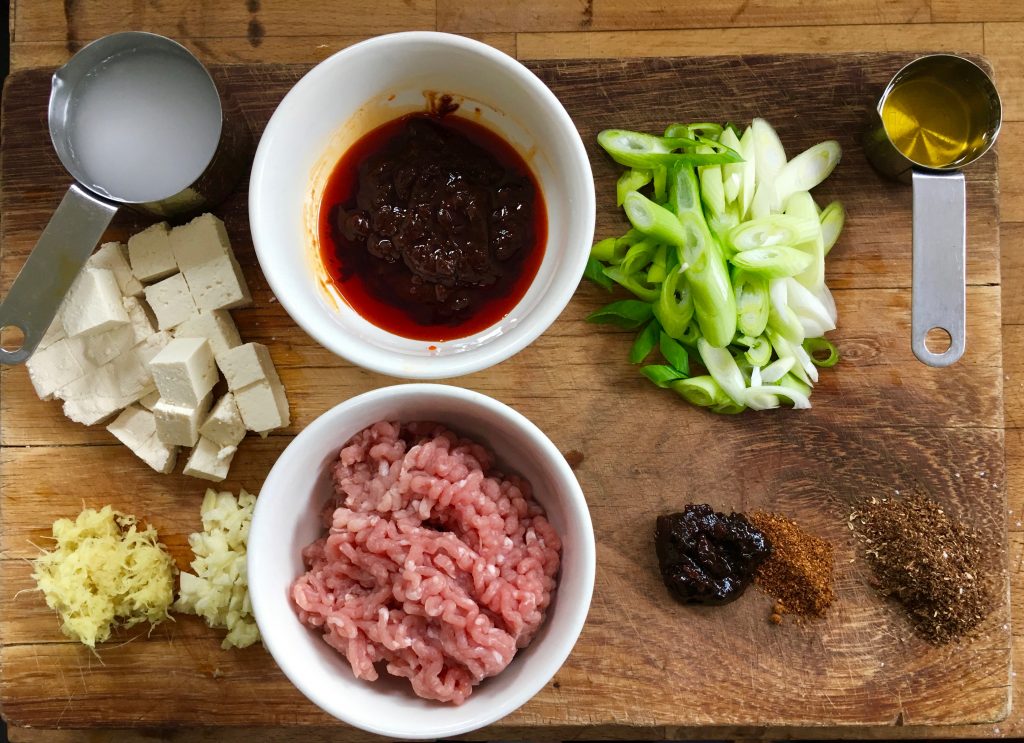 Method for Mapo Tofu
Method for Mapo Tofu
- Mix the potato flour with a little cold water to make a slurry. Save for later.
- Heat a wok until hot and add the Sichuan pepper corns. Roast until fragrant – you’ll want to sneeze. Crush to a powder in a pestle and mortar or make a larger quantity and use a spice grinder so you’ve got some on hand for future use.
- Add the stock to your wok and bring to a boil, add the tofu cubes and reduce to a simmer for 2 – 3 minutes until the tofu is firm. Remove the cooked tofu and reserve. Drain off the stock into a bowl and reserve.
- Dry the wok then place on a high heat, adding 2 – 3 tbs vegetable oil. When the oil is smoking, reduce the heat and add the garlic and ginger and stir-fry for 20 – 30 seconds. Add the doubanjiang and stir-fry for another 10 – 20 seconds.
- Add the tofu cubes and around half of the leftover chicken stock. Mix everything carefully to avoid damaging the tofu cubes. Simmer and sprinkle the mince in small handfuls so it doesn’t clump. Cook for a couple of minutes.
- Add the spring onions, black bean sauce and chilli oil and mix well. Cook for a further 30 seconds.
- Add the potato flour slurry and simmer until the sauce is thickened. Too thin? Add a little more slurry. Too thick? Add some more of the reserved stock. Once it’s right for you, remove from the heat and pour into a serving dish.
- Sprinkle with the Sichuan pepper powder and serve with rice.
If you want to know more about Sichuan cooking, then check out any of the books by Fuchsia Dunlop or visit www.themalaproject.com.

